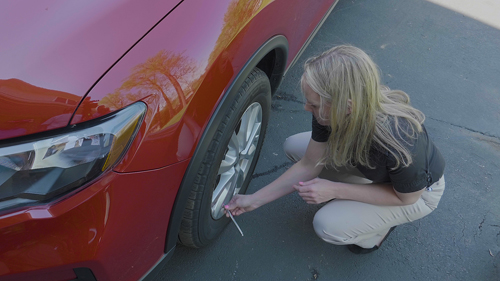Tire Replacement

Tires need to be replaced for a variety of reasons. In some instances, a single tire is all that is necessary, but the majority of tires are replaced in sets of two or four.
When the inflation pressure is regularly maintained and the tires are rotated every 5,000 to 7,000 miles, all four tires will typically be worn evenly and replaced at the end of their service life.
Drivers who fail to maintain and rotate their tires often find themselves needing to replace tires on one axle before the tires on the other axle are completely worn.
Since the tires are the only part of the vehicle that contacts the road, it is important to consult your tire professional and follow some simple recommendations for passenger ad light truck tire replacement.
How do I know when my tires need to be replaced?
The best way is to look for the wear indicators in the major grooves around the tires. These small rubber humps are positioned around the tire at 2/32 of an inch so when they are worn evenly with the tread on either side, the tire has less than 2/32 tread depth so it must be replaced. As the tread wears away, it gets closer and closer to the wear indicators making it easy to see when tires approaching the end of their service life.
You can also check for minimum tread depth using the “penny test”. Place a penny in a major tread groove of a tire with Lincoln’s head facing down. If the top of Lincoln’s head is visible at any point in any major tread groove, it’s a good sign that the tire needs to be replaced so drivers should take the vehicle to a tire professional.
You should also perform a visual inspection of the tread and sidewall. If there is any exposed steel or fabric and if any material is visible, have the tire(s) replaced immediately. It’s also important to check for any irregular tread wear, bulges or anomalies and have the tires inspected by a professional if anything seems abnormal or out of place.
How do I select replacement tires?
When selecting replacement tires, always follow all of the information listed on the vehicle’s tire information placard, which is typically located on the driver’s door, door jam or in the owner’s manual, when selecting replacement tires. The tire placard includes information such as the tire size, recommended inflation pressure, load index, and speed rating. Never install a tire with a load index that is lower than the original equipment tire listed on the placard or in the owner’s manual.
With the growing interest in vehicle customization, some drivers are interested in selecting custom tire and wheel packages that are different from the information listed on the placard. A tire professional must be consulted for this type of change.
Other factors to consider when selecting replacement tires are the Uniform Tire Quality Grading standards, or UTQG, which is divided into three categories:
- Treadwear - is a comparative figure that projects the approximate tread-life of the tire. However, due to different driving styles, road conditions and levels of maintenance, it is not a direct indicator of actual tread mileage.
- Traction - refers to the tire’s stopping ability on wet asphalt and concrete surfaces. AA is the best followed by A, B and then C.
- Temperature - indicates the resistance to heat with A being the highest followed by B and then C.
Once the proper tire for the vehicle has been selected, the best practice is to replace all four tires at the same time. In fact, on certain all-wheel-drive and four-wheel-drive vehicles, the vehicle manufacturers require all four tires to be replaced so the drive-train is not damaged.
However, when drivers fail to maintain or rotate their tires, the tires on one axle may need to be replaced before those on the other axle.
I am only replacing one tire, where should it be mounted?
If you are only replacing one tire, the best practice is to mount the new tire on the rear axle and pair it with the tire having the most remaining tread depth.
I am only replacing two tires, where should they be mounted?
While the best practice is to replace all four tires, when replacing only two tires, the new tires should be installed on the rear of the vehicle. If the new tires are installed on the front axle with worn tires on the rear, then the vehicle may be more likely to lose control when turning in wet or slippery conditions.
Should winter tires be installed on the front or the rear of a vehicle?
Winter tires are best applied to all vehicle positions. If winter tires are applied to the front axle of any vehicle, they must also be installed on the rear. If only two winter tires are being installed, they should be mounted on the rear of the vehicle.
Even with the best maintenance and rotation schedule, tires will eventually need to be replaced. By following the information on the tire placard and in the owner’s manual when selecting replacement tires, drivers can be confident that the best tires for the vehicle have been selected.